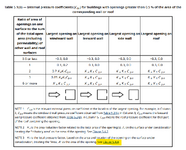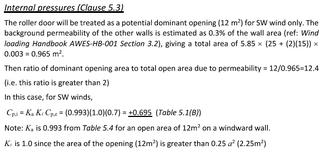This is a follow up from the following thread:
In it, someone asked:
to which @rowingengineer replied:
Can anyone confirm/clarify this? Are local pressures at the locations of openings now applied to all internal surfaces simultaneously, including loading of primary framing members?
Revised internal pressure calculation in AS/NZS 1170.2:2021?
In the recently revised wind code, there is a change to the way internal pressures are calculated for structures with dominant openings. The 2011 version defined the internal pressure coefficient as the external pressure coefficient at the location of the opening [i.e. Cp,i = Cp,e at the...
www.eng-tips.com
In it, someone asked:
For the Kl part, is it still only referring to cladding, cladding fixings, elements that supports cladding, and this fixing?
to which @rowingengineer replied:
For KL internal pressure it applies to all parts of the building. This has been clarified by the code committee.
Can anyone confirm/clarify this? Are local pressures at the locations of openings now applied to all internal surfaces simultaneously, including loading of primary framing members?
Last edited:




